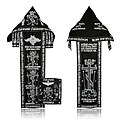Koukoulion

The koukoulion (
History
Related to the western cowl, it was the cap worn by Orthodox monks.[1][2] It is shown worn by emperors Michael IV, who died as a monk, in the Madrid Skylitzes.[3][4] Medieval orthodox monks did not have specific habits and uniforms related to the orders as in the West (for example the Benedictine habit or Franciscan habit), but each monastery set its own rules.[5] The monks wore a simple cap, often made of coarse and modest fabrics, that was called koukoulion.[5][6]
-
Monk wearing a koukoulion, from the Sacra Parallela[7]
-
Emperor Michael IV laying in bed and wearing the koukoulion, from the Madrid Skylitzes
-
Mitrophan of Voronezh wearing the koukoulion (19th century icon) [8]
-
Anthony of Kiev shown wearing a koukoulion.[9]
Great Schema From the 17th century, following the reforms of
-
Icon of St. Adrian of Ondrusov, wearing the black koukoulion. The lapets can be seen on his shoulders.
-
Slovenic great schema, with the koukoulion (hood) and the analavos
-
Philip Khorev (1802-1869) - schema monks of the Russian Orthodox Church, wearing the koukoulion hood
Patriarchal koukoulion
Patriarch of Moscow
The
The origin of the white patriarchal koukoulion is disputed.[12]
Archbishop
Instead,
In 1564, the Moscow Council adopted a code on the right of the Moscow metropolitan to wear a white koukoulion.[15][16] After the establishment of the patriarchate in Russia in 1589, the Moscow patriarchs began to wear the white koukoulion.[10]
Other
Koukoulia are also worn by the primates of certain other Orthodox churches, for example the Catholicos-Patriarch of All Georgia.
-
Leontiy of Rostov (1051-1077)
-
St.Tikhon of Moscowwearing the patriarchal white koukoulion.
-
Patriarch Kirill of Moscow wearing his koukoulion
See also
- Klobuk
- Skufia
- Apostolnik
- Cowl
- Epanokamelavkion
- Kalimavkion
- The Philippi Collection
References
- ^ a b c Robinson, Nalbro' Frazier (1916). Monasticism in the Orthodox Churches: Being an Introduction to the Study of Modern Hellenic and Slavonic Monachism and the Orthodox Profession Rites, Together with a Greek Dissertation on the Monastic Habit, Done in English, with Notes. Cope and Fenwick. p. 39.
- )
- OCLC 51900961.
- OCLC 51900961.
- ^ )
- OCLC 714724958.
- JSTOR 20788045.
- ^ "The Temple Gallery - specialists in Russian icons". www.templegallery.com. Retrieved 2021-06-27.
- ^ "День памяти прп. Антония - основоположника монашества на Руси". Церковно-Научный Центр "Православная Энциклопедия" (in Russian). Retrieved 2021-06-27.
- ^ OCLC 232995137.
- ^ "7 Types of Orthodox Clergy and Monastic Headgear". The Catalog of Good Deeds. Retrieved 2021-06-28.
- ^ JSTOR 4213137.
- ^ "ЭСБЕ/Белый клобук — Викитека". ru.wikisource.org (in Russian). Retrieved 2021-06-28.
- ^ "Святитель Леонтий Ростовский". ruvera.ru (in Russian). Retrieved 2021-06-28.
- ^ "Особенности богослужебного облачения Патриарха на Руси". Церковно-Научный Центр "Православная Энциклопедия" (in Russian). Retrieved 2021-06-28.
- JSTOR 24659105.
- Philippi, Dieter (2009). Sammlung Philippi – Kopfbedeckungen in Glaube, Religion und Spiritualität. St. Benno Verlag, Leipzig. ISBN 978-3-7462-2800-6.

![Monk wearing a koukoulion, from the Sacra Parallela[7]](http://upload.wikimedia.org/wikipedia/commons/thumb/2/20/Parisinus_Graecus_923%2C_folio_208r.png/53px-Parisinus_Graecus_923%2C_folio_208r.png)
![Mitrophan of Voronezh wearing the koukoulion (19th century icon) [8]](http://upload.wikimedia.org/wikipedia/commons/thumb/b/be/Mitrophan_of_Voronezh.jpg/102px-Mitrophan_of_Voronezh.jpg)
![Anthony of Kiev shown wearing a koukoulion.[9]](http://upload.wikimedia.org/wikipedia/commons/thumb/c/c9/Antony_Pechersky_%28fragment%29.jpg/81px-Antony_Pechersky_%28fragment%29.jpg)




